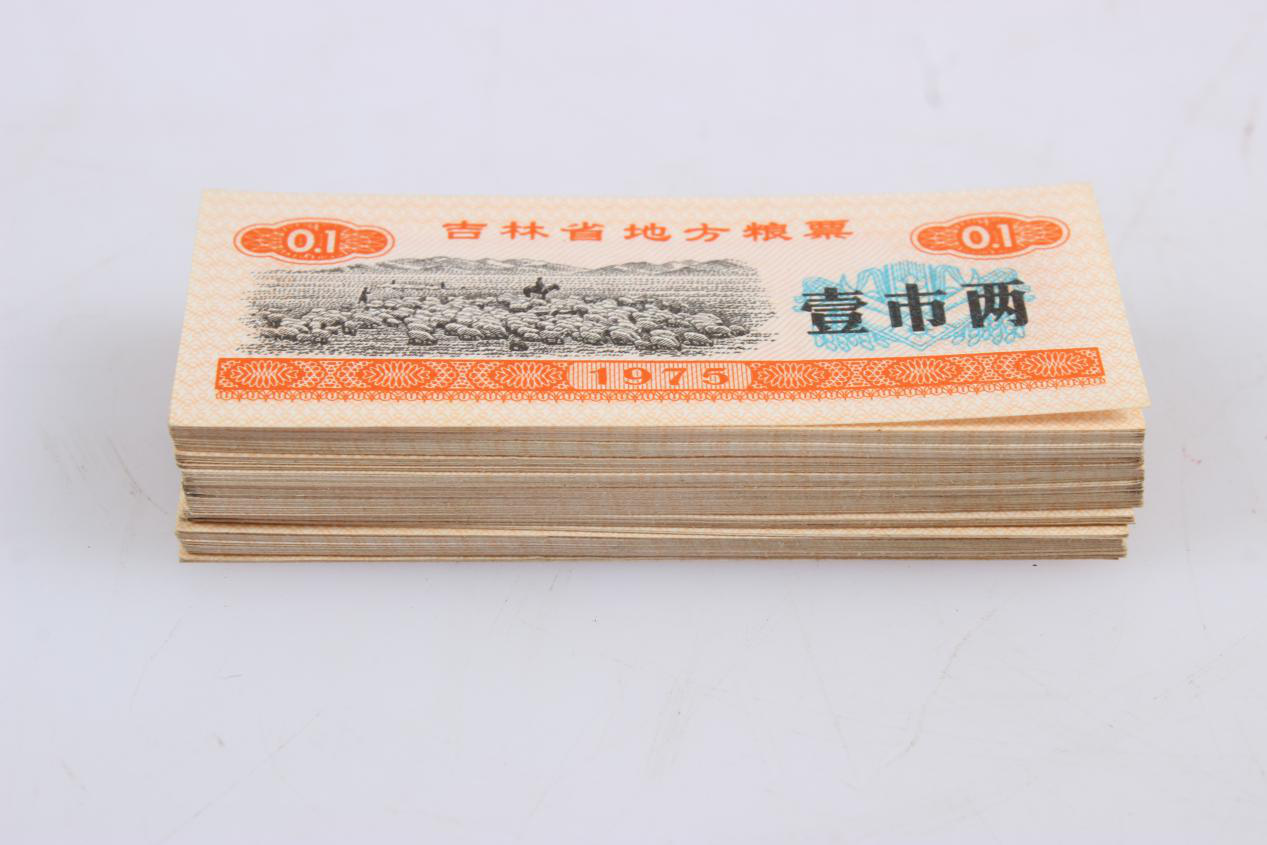1975 Local Food Tickets One City and Two Cities in Jilin Province
粮票作为一种实际的有价证券,在中国使用达40多年,随着社会的发展,它已退出了历史舞台,成为收藏者的新宠。粮票自身是没有价值的票证,但凭粮票可买到国家牌价粮食,实际上粮票成了一种有价证券。粮票的面值等于国家牌价粮价与市场价之差。目前中国已取消使用粮票,粮票很快进入了收藏品的行列,全国集“粮”爱好者也在不断扩大。但在粮票的诸多种类中,文革粮票却因其独特的历史背景备受关注。
As a practical securities, grain tickets have been used in China for more than 40 years. With the development of society, it has withdrawn from the historical stage and become a new favorite of collectors. Food tickets themselves are worthless tickets, but they can buy grain at the national price. In fact, food tic
kets have become a kind of marketable securities. The face value of the grain ticket is equal to the difference between the national price and the market price. At present, China has abolished the use of food stamps, food stamps soon entered the ranks of collections, and the national collection of "food" enthusiasts are also expanding. However, among many kinds of food stamps, the grain stamps of the Cultural Revolution attracted much attention because of their unique historical background.

文革是指在1966年5月16日至1976年10月期间,发生的一场由领导者错误发动被反革命集团利用给党、国家和各族人民带来严重灾难的内乱。这场动乱严重影响了当时生活在大陆的中国人,频繁的政治活动令经济活动近乎停顿,同时也消耗了不少的资源。因此,每当提起文革,每一位中国人都不得不叹息不已。
The Cultural Revolution refers to the civil strife that occurred between May 16, 1966 and October 1976, when the leaders mistakenly launched the civil strife which was exploited by the counter-revolutionary groups and brought serious disasters to the Party, the state and the people of all ethnic groups. The turmoil seriously affected the Chinese people living in the mainland at that time. Frequent political
activities brought economic activities to a standstill and consumed a lot of resources. Therefore, whenever the Cultural Revolution is mentioned, every Chinese has to sigh.
而对于该时期出现的收藏品,正因为其独特的社会政治背景,而成为收藏市场的明星。比如在此期间发行的全国山河一片红,在2012年嘉德春拍中以730.25万元成交;文革时期的无志号邮票,市场价格也已近20万。此期间浮现在人们生活中,地位仅次于人民币,并被誉为“生命票”的粮票,同样有着”红色”背景,市场表现更是令人刮目相。
As for the collections appearing in this period, because of their unique social and political background, they became the stars of the collection market. For example, during this period, the national mountains and rivers became red, and in the spring of Jiadechun in 2012, the transaction was completed with 73.025 million yuan; during the Cultural Revolution, the market price of unsigned stamps was nearly 200,000 yuan. During this period, it emerged in people's lives, ranking second only to the RMB, and is known as the "life ticket" of grain tickets. It also has a "red" background, and the market performance is even more impressive.
同样,1975年吉林省地方粮票壹市斤也是诞生在文革期间,这枚粮票从发行到使用到销毁都经历了严格的控制,而且1975年吉林省地方粮票壹市斤距今已有四十多年,即使保留下来品相也已经不在完好。但就粮票收藏价值来讲,1975年吉林省地方粮票壹市两因其独特的社会背景,非凡的纪念意义,使其在市场中脱颖而出。
Similarly, in 1975, a local grain ticket in Jilin Province was born during the Cultural Revolution. The issue, use and destruction of this food ticket had undergone strict control. In 1975, a local grain ticket in Jilin Province has been more than 40 years since then, even if the remaining products are not in good condition. But as far as the collection value of grain tickets is concerned, in 1975, Jilin Province's local grain ticket one city catty stood out in the market because of its unique social background and extraordinary commemorative significance。
粮票收藏发展到今天,仅仅单枚规格的搜集已经不再占据主流,更多的收藏爱好者更是转向整包规格的粮票。对于1975年吉林省地方粮票而言,一方面受文革特殊时期的影响,发行使用受严格控制,能留下几张已经是很难得事情了,更不敢想象整包的规格。所以吉林省地方粮票具有极高的升值空间和收藏价值。
With the development of grain ticket collection, the collection of single specifications no longer occupies the mainstream, and more collectors are turning to the whole package of grain tickets. For the local grain tickets in Jilin Province in 1975, on the one hand, due to the special period of the Cultural Revolution, the issuance and use of them were strictly controlled. It was very rare to leave a few tickets, let alone imagine the specifications of the whole package. Therefore, the local grain stamps in Jilin Province have very high appreciation space and collection value.


